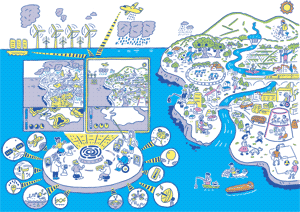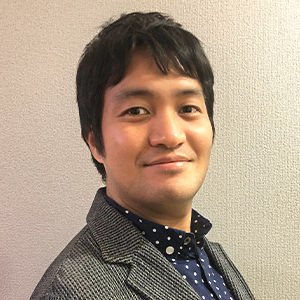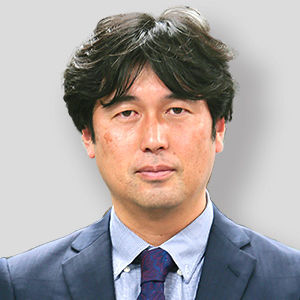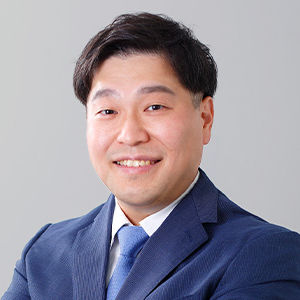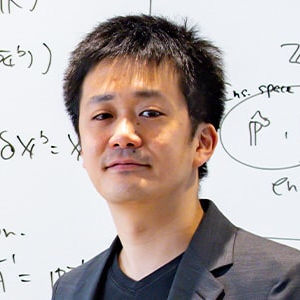Program

Moonshot Goal8Realization of a society safe from the threat of extreme winds and rains by controlling and modifying the weather by 2050.
Program Director (PD)MIYOSHI TakemasaTeam Principal, Center for Computational Science, Data Assimilation Research Team, RIKEN
Outline
Global warming means that wind and flood damage caused by extreme weather events such as typhoons and torrential rains are becoming more severe and frequent. If it is possible to change the intensity, timing, and/or location of extreme weather events that lead to disasters, it may be possible to avoid or dramatically reduce the resulting damage. In this program, we will conduct R&D aimed at: gaining a deeper understanding of extreme weather, which is essential for the development of weather control theory; improving weather forecasting technology such as weather modeling, data assimilation and ensemble methods; and realizing weather control technology that is socially, technically, and economically feasible.
A Vision of Society in 2050 (Illustrated Guide)
What might the future look like in 2050 if Goal 8 is realized? An illustrated guide.
Message from PD
Our goal is to significantly reduce the damage caused by extreme windstorms and floods, which are becoming more severe due to global warming and other factors, by developing weather control technology to change the intensity, timing, and location of typhoons and torrential rains. In our R&D we will combine control theory using numerical simulations, control technology that applies artificial disturbances to the atmosphere, and elements related to fundamental mathematics and ELSI. Weather control has long been a dream of humanity, and through my leadership as PD I hope to realize it as an open technology.
R&D Projects
Selected in FY2021
Selected in FY2023
Past Project
| Project Manager | TAKAGAKI Naohisa Professor, Graduate School of Engineering, University of Hyogo |
|---|---|
| Outline | To realize weather control, highly accurate weather forecasting is essential. In particular, for controlling typhoons, there are two bottlenecks: (1) low accuracy of typhoon intensity predictions; (2) difficulty of distinguishing natural and control effects. This project aims to solve these bottlenecks by investigating the mechanism of momentum and heat transfer across the sea surface under typhoons, and formulating the momentum and heat fluxes using parameters associated with wave-breaking and wind waves through a large laboratory experiment for simulating typhoons. |
| Project Manager | NISHIZAWA Seiya Senior Scientist, RIKEN Center for Computational Science |
|---|---|
| Outline | To realize weather control, we must solve a bottleneck to determining the optimal control method: that it is difficult to accurately estimate the probability associated with properties of local atmospheric phenomena, such as location, time, intensity. This project aims to develop an atmospheric simulation model suitable for this estimation which solves several problems inherent to current atmospheric simulation models, developing new computation schemes that are qualitatively different from conventional ones. |
| Project Manager | NONOMURA Taku Professor, Graduate School of Engineering, Nagoya University |
|---|---|
| Outline | To realize weather control, we need to solve the bottleneck that the positions for actuators to maximize weather control effects are unknown. This project aims to organize, develop and evaluate actuator position optimization methods. We will show through weather simulation experiments that the obtained actuator positions can be used to improve control effects. |
| Project Manager | MORI Shuichi Principal Researcher, Center for Coupled Ocean-Atmosphere Research (CCOAR) of Research Institute for Global Change (RIGC), Japan Agency for Marine-Earth Science and Technology (JAMSTEC) |
|---|---|
| Outline | To realize weather control, nature needs to be continuously monitored. For typhoons it is important to continuously monitor the marine atmosphere and ocean surface layer near the typhoon center, which play important roles in the typhoon development process. However, it is difficult to conduct this monitoring via aircraft or satellites, which means it is a bottleneck for weather control. This project aims to develop unmanned maritime vehicles that can be virtually moored near the area of a typhoon center and continuously observe the atmosphere-ocean data along the movement path of the typhoon. |
| Project Manager | KOTSUKI Shunji Professor, Institute for Advanced Academic Research / Center for Environmental Remote Sensing, Chiba University |
|---|---|
| Outline | To achieve weather control, we need to enable discussions on a bottleneck for decision-making: the way to maximize the effect of control. To quantify weather controllability, this project investigates meteorological landscapes that separate disaster and non-disaster regimes which can be controlled by small operations through deep learning applied to historical disaster events. We also estimate economical damage and impacted populations throughout Japan under non-controlled/controlled scenarios, in order to quantify avoidable damage by the weather control. |
Advisors
Click here to see the list of advisors
Advisors (Domestic)
| NAKAZAWA Tetsuo* | Former Director, Typhoon Research Department, Meteorological Research Institute, Japan |
|---|---|
| SAKAJO Takashi* | Professor, Graduate School of Science, Kyoto University |
| IMURA Jun-ichi | Executive Vice President/Professor, Department of Systems and Control Engineering, School of Engineering, Institute of Science Tokyo |
| USHIO Tomoo | Professor, Graduate School of Engineering, The University of Osaka |
| OHARA Miho | Professor, Center for Integrated Disaster Information Research, Interfaculty Initiative in Information Studies, The University of Tokyo |
| SAITO Kazuo | Senior Engineer, International Affairs Department, Japan Meteorological Business Support Center |
| SATO Yoshiaki | Counselor for Reseach and Development, Administration Department, Japan Meteorological Agency |
| SHINEHA Ryuma | Associate Professor, Graduate School of Media Design, Keio University. |
| SUITO Hiroshi | Professor, Advanced Institute for Materials Research, Tohoku University |
| YAMADA Michio | Project professor, Research Institute for Mathematical Sciences, Kyoto University |
| YODEN Shigeo | Professor Emeritus, Kyoto University |
*Sub Program Director
Advisors (Overseas)
| YANG, Shu-Chih | Professor, Department of Atmospheric Sciences, National Central University |
|---|---|
| PARK, Seon Ki | Professor, Climate and Energy Systems Engineering, Ewha Womans University |
| REICH, Sebastian | Professor, Mathematics, University of Potsdam |
Goal 8 News
Contact
Goal 8 Secretariat
Department of Moonshot Research and Development Program, Japan Science and Technology Agency
e-mail moonshot-goal8
